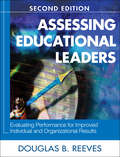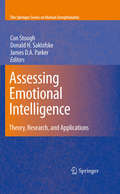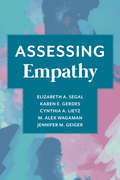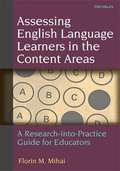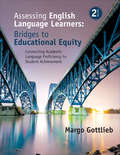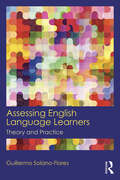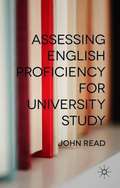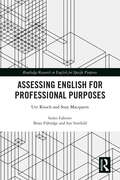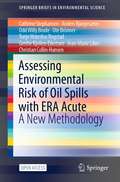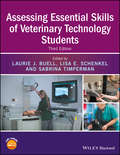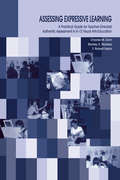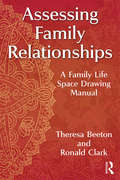- Table View
- List View
Assessing Educational Leaders: Evaluating Performance for Improved Individual and Organizational Results
by Douglas B. ReevesFeaturing real-world examples, this revised bestseller shows you how to improve educational leadership and organizational performance through a multidimensional leadership assessment system.
Assessing Emotional Intelligence: Theory, Research, and Applications (The Springer Series on Human Exceptionality)
by James D. Parker Donald H. Saklofske Con StoughManaging human emotions plays a critical role in everyday functioning. After years of lively debate on the significance and validity of its construct, emotional intelligence (EI) has generated a robust body of theories, research studies, and measures. Assessing Emotional Intelligence: Theory, Research, and Applications strengthens this theoretical and evidence base by addressing the most recent advances and emerging possibilities in EI assessment, research, and applications. This volume demonstrates the study and application of EI across disciplines, ranging from psychometrics and neurobiology to education and industry. Assessing Emotional Intelligence carefully critiques the key measurement issues in EI, and leading experts present EI as eminently practical and thoroughly contemporary as they offer the latest findings on: EI instruments, including the EQ-I, MSCEIT, TEIQue, Genos Emotional Intelligence Inventory, and the Assessing Emotions Scale. The role of EI across clinical disorders. Training professionals and staff to apply EI in the workplace. Relationships between EI and educational outcomes. Uses of EI in sports psychology. The cross-cultural relevance of EI. As the contributors to this volume in the Springer Series on Human Exceptionality make clear, these insights and methods hold rich potential for professionals in such fields as social and personality psychology, industrial and organizational psychology, psychiatry, business, and education.
Assessing Empathy
by Cynthia Lietz Elizabeth Segal Karen Gerdes M. Alex Wagaman Jennifer GeigerEmpathy is a widely used term, but it is also difficult to define. In recent years, the field of cognitive neuroscience has made impressive strides in identifying neural networks in the brain related to or triggered by empathy. Still, what exactly do we mean when we say that someone has—or lacks—empathy? How is empathy distinguished from sympathy or pity? And is society truly suffering from an "empathy deficit," as some experts have charged??In Assessing Empathy, Elizabeth A. Segal and colleagues marshal years of research to present a comprehensive definition of empathy, one that links neuroscientific evidence to human service practice. The book begins with a discussion of our current understanding of empathy in neurological, biological, and behavioral terms. The authors explain why empathy is important on both the individual and societal levels. They then introduce the concepts of interpersonal empathy and social empathy, and how these processes can interrelate or operate separately. Finally, they examine the weaknesses of extant empathy assessments before introducing three new, validated measures: the Empathy Assessment Index, the Social Empathy Index, and the Interpersonal and Social Empathy Index.
Assessing English Language Learners In The Content Areas: A Research-into-practice Guide For Educators
by Florin MihaiAssessing English Language Learners in the Content Areas: A Research-into-Practice Guide for Educators seeks to provide guidance to classroom teachers, staff developers, and test-item designers who want to improve ELL assessment outcomes, particularly in the areas of math, science and social studies. The first two chapters of the book establish the background for the discussion of content-area assessment for ELLs, examining several important characteristics of this rapidly growing student population (as well as critical legislation affecting ELLs) and providing a description of various forms of assessment, including how ELL assessment is different from the assessment of English-proficient students Important assessment principles that educators should use in their evaluation of tests or other forms of measurement are provided. Other chapters review ELL test accommodations nationwide (because, surprisingly, most teachers do not know what they can and cannot allow) and the research on the effectiveness of these types of accommodations. The book analyzes the characteristics of alternative assessment; it discusses three popular alternative assessment instruments (performance assessment, curriculum-based measurement, and portfolios) and makes recommendations as to how to increase the validity, reliability, and practicality of alternative assessments. The book proposes fundamental assessment practices to help content area teachers in their evaluation of their ELL progress.
Assessing English Language Learners: Connecting Academic Language Proficiency to Student Achievement
by Dr Margo GottliebBuild the bridges for English language learners to reach success! This thoroughly updated edition of Gottlieb’s classic delivers a complete set of tools, techniques, and ideas for planning and implementing instructional assessment of ELLs. The book includes: A focus on academic language use in every discipline, from mathematics to social studies, within and across language domains Emphasis on linguistically and culturally responsive assessment as a key driver for measuring academic achievement A reconceptualization of assessment “as,” “for,” and “of” learning Reflection questions to stimulate discussion around how students, teachers, and administrators can all have a voice in decision making
Assessing English Language Learners: Connecting Academic Language Proficiency to Student Achievement
by Dr Margo GottliebBuild the bridges for English language learners to reach success! This thoroughly updated edition of Gottlieb’s classic delivers a complete set of tools, techniques, and ideas for planning and implementing instructional assessment of ELLs. The book includes: A focus on academic language use in every discipline, from mathematics to social studies, within and across language domains Emphasis on linguistically and culturally responsive assessment as a key driver for measuring academic achievement A reconceptualization of assessment “as,” “for,” and “of” learning Reflection questions to stimulate discussion around how students, teachers, and administrators can all have a voice in decision making
Assessing English Language Learners: Theory and Practice
by Guillermo Solano FloresAssessing English Language Learners explains and illustrates the main ideas underlying assessment as an activity intimately linked to instruction and the basic principles for developing, using, selecting, and adapting assessment instruments and strategies to assess content knowledge in English language learners (ELLs). Sensitive to the professional development needs of both in-service and pre-service mainstream teachers with ELLs in their classrooms and those receiving formal training to teach culturally and linguistically diverse students, the text is designed to engage readers in viewing assessment as a critical part of teaching appreciating that assessments provide teachers with valuable information about their students’ learning and thinking becoming aware of the relationship among language, culture, and testing understanding the reasoning that guides test construction recognizing the limitations of testing practices being confident that assessment is an activity classroom teachers (not only accountability specialists) can perform Highlighting alternative, multidisciplinary approaches that address linguistic and cultural diversity in testing, this text, enhanced by multiple field-tested exercises and examples of different forms of assessment, is ideal for any course covering the theory and practice of ELL assessment.
Assessing English Language Proficiency in U.S. K–12 Schools
by Mikyung Kim WolfAssessing English Language Proficiency in U.S. K–12 Schools offers comprehensive background information about the generation of standards-based, English language proficiency (ELP) assessments used in U.S. K–12 school settings. The chapters in this book address a variety of key issues involved in the development and use of those assessments: defining an ELP construct driven by new academic content and ELP standards, using technology for K–12 ELP assessments, addressing the needs of various English learner (EL) students taking the assessments, connecting assessment with teaching and learning, and substantiating validity claims. Each chapter also contains suggestions for future research that will contribute to the next generation of K–12 ELP assessments and improve policies and practices in the use of the assessments. This book is intended to be a useful resource for researchers, graduate students, test developers, practitioners, and policymakers who are interested in learning more about large-scale, standards-based ELP assessments for K–12 EL students.
Assessing English Learners in the Content Areas, Second Edition: A Research-into-Practice Guide for Educators
by Florin MihaiAssessing English Learners in the Content Areas, Second Edition: A Research-into-Practice Guide for Educators
Assessing English Proficiency for University Study
by John ReadThis book focuses on strategies and procedures for assessing the academic language ability of students entering an English-medium university, so that those with significant needs can have access to opportunities to enhance their language skills.
Assessing English for Professional Purposes (Routledge Research in English for Specific Purposes)
by Ute Knoch Susy MacqueenAssessing English for Professional Purposes provides a state-of-the-art account of the various kinds of language assessments used to determine people’s abilities to function linguistically in the workplace. At a time when professional expertise is increasingly mobile and diverse, with highly trained professionals migrating across national boundaries to apply their skills in English-speaking settings, this book offers a renewed agenda for inquiry into language assessments for professional purposes (LAPP). Many of these experts work in high-risk environments where communication breakdowns can have serious consequences. This risk has been identified by governments and professional bodies, who implement language tests for gate-keeping purposes. Through a sociological lens of risk and responsibility, this book: provides a detailed overview of both foundational and recent literature in the field; offers conceptual tools for specific purpose assessment, including a socially oriented theory of construct; develops theory and practice in key areas, such as needs analysis, test development, validation and policy; significantly broadens the scope of the assessment of English for professional purposes to include a range of assessment practices for both professionals and laypeople in professional settings. Assessing English for Professional Purposes is key reading for researchers, graduate students and practitioners working in the area of English for Specific Purposes assessment.
Assessing Environmental Risk of Oil Spills with ERA Acute: A New Methodology (SpringerBriefs in Environmental Science)
by Cathrine Stephansen Anders Bjørgesæter Odd Willy Brude Ute Brönner Tonje Waterloo Rogstad Grethe Kjeilen-Eilertsen Jean-Marie Libre Christian Collin-HansenThis open access book introduces readers to a new methodology for assessing the risks to the marine environment following accidental oil spills. The methodology will soon be implemented on the Norwegian Continental Shelf and will be complemented by guidelines for its use in a regulatory framework. The brief book is intended to provide international readers with a basic grasp of what the ERA Acute methodology consists of, what its applications are, and the underlying impact and restoration models used in its development. The content is divided into three main parts: an introduction and overview of risk management applications for generalists at the management level, a model overview for generalist scientists, and a more detailed final section for risk assessment professionals, which presents the results of the validation and sensitivity testing.
Assessing Equity in the Distribution of Fisheries Management Benefits: Data And Information Availability
by Ocean Studies Board Division on Earth and Life Studies National Academies of Sciences, Engineering, and Medicine Committee on Assessing Equity in the Distribution of Fisheries Management Benefits: Data and Information AvailabilityFisheries are essential to the global economy and feed billions around the world; they, support individuals and communities, and sustain cultural heritages and livelihoods. Although U.S. fisheries have been managed for commercial fishing historically, there has been an interest more recently in better accounting for and meeting the needs of the diverse individuals, groups, and communities that rely on and participate in fisheries, or aspire to do so. At the request of the National Marine Fisheries Service, this report considers information needs and data collection for assessing the distribution of fisheries management benefits. Assessing Equity in the Distribution of Fisheries Management Benefits identifies information needs, obstacles to collecting information, and potential methodologies for assessing where and to whom the primary benefits of commercial and for-hire fishery management accrue.
Assessing Essential Skills of Veterinary Technology Students
by Laurie J. Buell Lisa E. Schenkel Sabrina Timperman Amanda Colón Sandra Lynn BertholfStandardized assessment criteria covering all essential skills from the nine areas required by the American Veterinary Medical Association Committee on Veterinary Technician Education and Activities The newly revised and updated Fourth Edition of Assessing Essential Skills of Veterinary Technology Students provides a comprehensive review of the required American Veterinary Medical Association Committee on Veterinary Technician Education and Activities (AVMA CVTEA®) essential skills for completion of a veterinary technology degree. Each essential skill includes assessment criteria as well as decision-making instructions necessary to demonstrate proficiency both academically and professionally. The text is organized based on the categories provided by the AVMA CVTEA, making it easy for an instructor and students to locate the assessment criteria for a particular essential skill relative to their course. Several guidelines from veterinary organizations regarding standard of care in veterinary medicine have been updated since the publication of the previous edition, including 2018 A AHA Infection Control, Prevention and Biosecurity Guidelines, 2022 AAHA Pain Management Guidelines for Dogs and Cats, 2021 AAHA/AAFP Feline Life Stages Guidelines, 2019 AAHA Canine Life Stages Guidelines, 2021 AAHA Nutrition and Weight Management Guidelines, 2023 AAHA Technician Utilization Guidelines, and others. Written by highly qualified authors, Assessing Essential Skills of Veterinary Technology Students includes assessment criteria that addresses the knowledge, decision-making capabilities, and hands-on skills for the following: Pharmacologic fundamentals of drug administration, pharmacy essentials of drug dispensing, compliance with state and federal regulation, and monitoring of therapeutic responses.Ethics, jurisprudence, and communication in veterinary management.Husbandry, nutrition, and therapeutics of common domestic species, handling and restraint, patient assessment, and dental procedures in small animals.Fundamentals of and experiences with common surgical procedures, patient management and use of anesthetic equipment, proper surgical assistance, pain management, management of surgical equipment and facilities, and perioperative management.Diagnostic laboratory procedures and management of laboratory specimens and equipment, parasitology of common domestic species and diagnostic procedures for parasite, microbiologic procedure and evaluations and necropsy procedures.Avian, exotic, small, and large animal husbandry and nursing skills. The Fourth Edition of Assessing Essential Skills of Veterinary Technology Students is an essential study resource for all undergraduate students enrolled in an AVMA CVTEA accredited veterinary technology program and an excellent teaching resource for instructors of veterinary technology courses.
Assessing Essential Skills of Veterinary Technology Students
by Laurie J. Buell Lisa E. Schenkel Sabrina TimpermanAssessing Essential Skills of Veterinary Technology Students, Third Edition provides students and instructors with clear guidance on how to evaluate student performance of skills required to enter the veterinary technology profession. Provides students with clear guidance on the capabilities they are expected to demonstrate and how they will be evaluated Gives instructors a standardized framework for assessing students’ performance Offers tools for comparing standards of competency Covers management, pharmacology, medical nursing, anesthesia and analgesia, surgical nursing, laboratory procedures, radiography, laboratory animal care, and exotic animal nursing Includes access to a companion website with a downloadable log for recording progress
Assessing Evidence to Improve Population Health and Wellbeing (Transforming Public Health Practice Series)
by Carmen AceijasWritten to support practitioners undertaking a Masters in public health, this book considers the main concepts, issues and methodologies of the second core competence of the Public Health Skills and Career Framework: 'Assessment of evidence of the effectiveness of interventions, programmes and services to improve population health and wellbeing'. Coverage includes the theoretical definition of evidence and its use in public health, the role of critical appraisal methods and tools in evidence assessment and how Effectiveness, Efficiency and Quality inform evidence. The book is packed with case studies and activities to help link theory and practice and prompt personal reflection.
Assessing Exchange Rate Competitiveness in the Eastern Caribbean Currency Union1
by Paul Cashin Yan Sun Emilio PinedaA report from the International Monetary Fund.
Assessing Expressive Learning: A Practical Guide for Teacher-directed Authentic Assessment in K-12 Visual Arts Education
by Charles M. Dorn Robert Sabol Stanley S. Madeja F. Robert SabolAssessing Expressive Learning is the only book in the art education field to date to propose and support a research-supported teacher-directed authentic assessment model for evaluating K-12 studio art, and to offer practical information on how to implement the model. This practical text for developing visual arts assessment for grades 1-12 is based on and supported by the results of a year-long research effort primarily sponsored by the National Endowment for the Arts, involving 70 art teachers and 1,500 students in 12 school districts in Florida, Indiana, and Illinois. The purpose of the study was to demonstrate that creative artwork by K-12 students can be empirically assessed using quantitative measures that are consistent with the philosophical assumptions of authentic learning and with the means and ends of art, and that these measures can reliably assess student art growth. A further goal was to provide a rationale for the assessment of student art as an essential part of the K-12 instructional program and to encourage art teachers to take responsibility for and assume a leadership role in the assessment of art learning in the school and the school district. Assessing Expressive Learning: *reports on current assessment methods but also stresses a time-tested portfolio assessment process that can be used or adapted for use in any K-12 art classroom; *includes the assessment instruments used in the study and several case studies of art teachers using electronic portfolios of student work, a bibliography of major art assessment efforts, and a critical review of current methods; *is designed to be teacher- and system-friendly, unlike many other art assessment publications that provide only a review of information on assessment; and *both documents an experiment where artistic values and aesthetic issues were considered paramount in the education of K-12 students in the visual arts, and also serves as a guide for the conduct of similar experiments by art teachers in the nation's schools--the research methodology and results are reported in an appendix in a format that will enable educational researchers to duplicate the study. This volume is ideal as a text for upper-division undergraduate and graduate classes in visual arts education assessment, and highly relevant for college art education professors, researchers, and school district personnel involved in the education and supervision of art teachers, and researchers interested in performance measurement.
Assessing External Sustainability in India
by Paul Cashin Tim CallenA report from the International Monetary Fund.
Assessing Family Relationships: A Family Life Space Drawing Manual
by Theresa A. Beeton Ronald A. ClarkAssessing Family Relationships shows mental health professionals how to utilize the Family Life Space Drawing (the FLSD), a family assessment tool that incorporates information from multiple family members while building connections between the clinician and the client. In this manual, Theresa A. Beeton and Ronald A. Clark demonstrate the usefulness of the FLSD in both family and couple counseling. As a task-centered assessment tool, the FLSD enables an interactive and personalized process of counseling, which helps individuals to express concerns and information about themselves in an indirect and nonthreatening manner. Chapters are illustrated throughout with case studies and drawings adapted from the authors’ own clinical experience, and the manual offers an overview of the history of the FLSD, as well as where future research is headed. Providing a practical explanation of how to complete the FLSD process, Assessing Family Relationships will be highly relevant to couple and family therapists, as well as clinical social workers, who are interested in updating their practice with innovative family assessment research and techniques.
Assessing Feasibility with Value-laden Models: Discussing the Normativity of Integrated Assessment Models
by Simon HollnaicherIn this Open-Access-book, the author investigates the value dimension of Integrated Assessment Models and their application to questions of feasibility. Integrated models provide a quantified representation of the interaction between the socio-economic system with the climate and serve as a pivotal tool at the intersection of climate science, policymakers, and society. This book critically examines how IAMs approach the concept of feasibility. It unpacks the value assumptions embedded within integrated modeling, critiques the implicit normativity of these models, and proposes principles for responsibly managing value judgments in scientific advice. Arguing for a thick conception of feasibility—one that integrates key normative dimensions—it highlights the gap between conceptual discussions of feasibility and the scientific practices that inform feasibility assessments. Addressed to both philosophers and integrated modelers, this book sheds light on the implicit values shaping our collective visions for the future.
Assessing Financial System Vulnerabilities
by R. Barry Johnston Liliana Schumacher Jingqing ChaiA report from the International Monetary Fund.
Assessing Fiscal Stress
by Emanuele Baldacci Nazim Belhocine Iva Petrova Gabriela Dobrescu Samah MazraaniA report from the International Monetary Fund.
Assessing Fiscal Sustainability Under Uncertainty
by George Kopits Theodore M. BarnhillA report from the International Monetary Fund.
Assessing Fiscal Sustainability in Theory and Practice1
by Richard Hemming Nigel ChalkA report from the International Monetary Fund.
